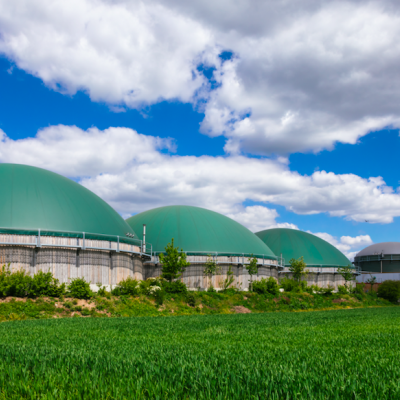Anaerobic digestion plants promise to digest the huge volumes of manure and slurries produced by UK livestock farms, and produce biomethane for the gas grid as well as fertiliser for crops. However, they may actually drive more and worse meat production, says Martin Bowman of Feedback.
Building anaerobic digestion (AD) plants to digest animal wastes has often been presented as a win-win option: it captures much of the methane that would normally be emitted from manures and slurries, and puts it to good use. From this perspective, sending animal slurries to AD seems like a straightforward way to mitigate the impact of meat production. In Feedback’s recent report Bad Energy: Defining the Role of Biogas in a Net Zero Future we argue it is not so simple, and support for AD may have perverse outcomes.
Propping up the intensive livestock industry
Disposal of litter and manure, within current environmental legislation, is a key constraint to the expansion of the intensive meat industry. Producers are faced with the challenge of what to do with all the extra animal wastes in order to obtain permits. By providing an infrastructure for dealing with these wastes, AD may incentivise both more and worse meat production.
Some studies have found that AD may only be viable for large-scale intensive livestock facilities. As slurries and manure have a very low energy density, very large amounts of wastes are required to make it economically viable, alongside subsidies or bio-energy crops, like maize, for co-digesting with manures. It is already being used to scale up intensive production. For example, when Broadley Copse Farm in Sussex applied to significantly expand its operation to 50,000 bacon pigs a year, an AD plant was “key to getting the project up and running” and gaining the permit. Now, in order to pay off the £10 million this AD plant cost to build, it must be supplied with 70 tonnes of pig manure per day, along with straw and some 20 tonnes of maize – locking in demand for the huge volumes of manure and damaging bio-energy crops for decades.
High subsidies for AD can help expand the polluting livestock industry, as illustrated by Northern Ireland. In 2013, Northern Ireland’s Going for Growth strategy was launched to drive a huge expansion of intensive pig and poultry production locally. By highly subsidising AD plants, the government was able to provide an outlet for all the extra animal wastes, lower waste disposal costs and help factory farms to gain planning permission and bypass nitrate regulations. Instead of paying for their chicken litter to be disposed of, at about £90 per tonne, producers were now paid for their wastes by the AD plants. For Moy Park farms, NI’s biggest poultry producer, Feedback has calculated this would result in at least £12 million per year in savings. By 2020, Northern Ireland was producing 41% more pigs and 30% more chickens than in 2013, mainly in intensive farming facilities.
A sticking plaster compared with less meat
The AD industry sells itself as a way to lower the emissions of the “difficult to decarbonise” agriculture sector, and to deal with “unavoidable wastes” without lowering production. But producing less and better meat both prevents these animal wastes arising in the first place, and is the easiest way to decarbonise the agriculture sector.
A report commissioned by the Committee on Climate Change (CCC) estimates that a 50% reduction in the UK’s beef, lamb and dairy consumption by 2050 could result in a 37% reduction in the total UK agricultural sector’s domestic emissions by 2050. This would also free up at least 4.2 million hectares of grassland with potential for vast carbon sequestration by tree planting, nature restoration and shifts to more agro-ecological production. If almost all of the UK’s manure was sent to AD (which is highly unlikely), it would only bring down UK agriculture emissions by a maximum of 27 per cent – and its emissions savings potential would decline significantly below these levels in future decarbonisation contexts where energy grids are decarbonised and slurry storage improves. It would be far more effective to prioritise reducing meat production in the first place.
What role then for AD?
Our report, however, does find that there is a “sustainable niche” for AD. Our starting point should be to halve UK meat production and consumption by 2030, and to prioritise policies to make this happen – with AD only used to manage wastes arising in this context. Eating Better’s Roadmap, Better by Half urges a shift away from intensive farming, reducing stock and focusing on climate friendly farming practices. Rather than subsidising cheap waste disposal for the largest most polluting intensive livestock producers through AD, taxes and regulations should be introduced that make the cost of running the most polluting forms of livestock production more expensive – such as taxes on methane and nitrate emissions, and bringing forward the ban on open slurry storage. The UK should investigate whether AD can be made to work for smaller-scale more sustainable livestock farmers, to improve their livelihoods and support a transition to better meat, and prioritise subsidies to this purpose. Only by keeping AD within its “sustainable niche” in this way will it be a friend not a foe to the priority which is “less and better” meat.
Martin Bowman is Senior Policy and Campaigns Manager at Feedback, and lead author of the Bad Energy report.
